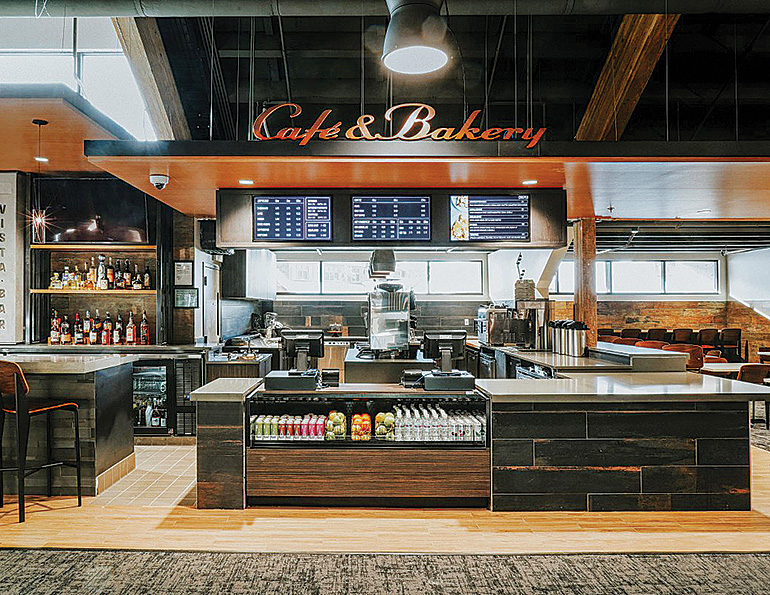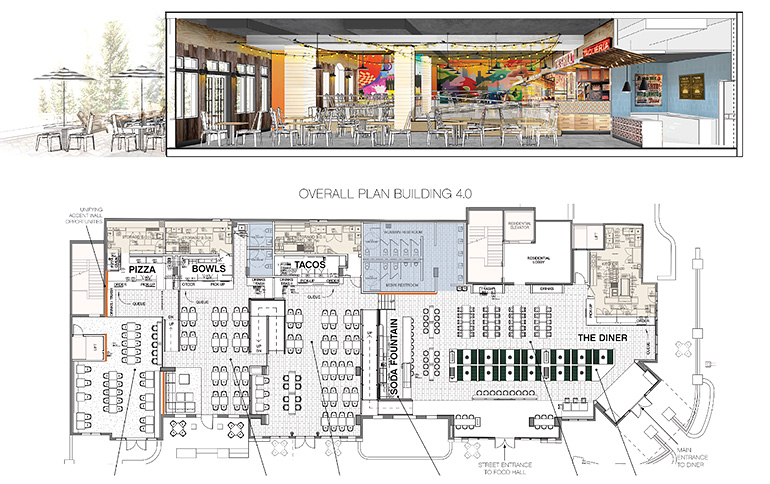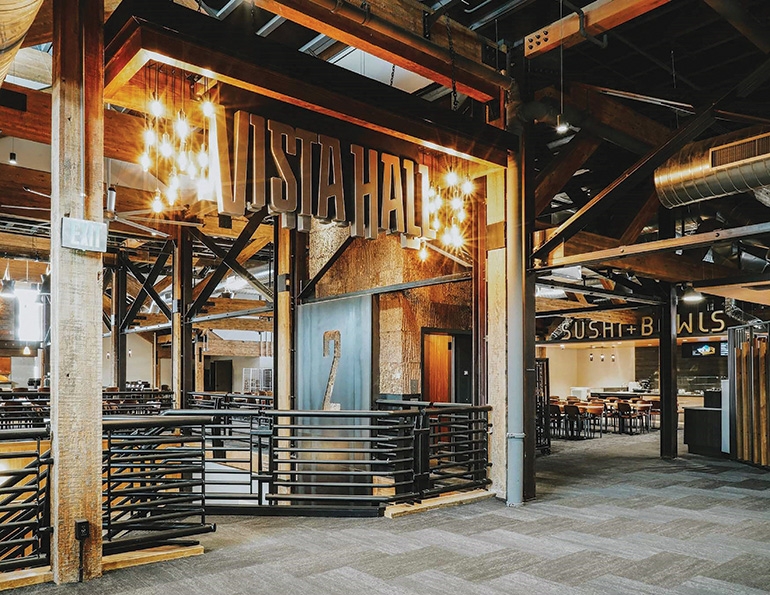Think back a year ago. The restrictions and unknowns related to the Covid-19 pandemic had many sitting on pins and needles about all sorts of things, including how the mountain resort industry should tackle food and beverage operations in an era of health concerns and capacity limits. A plethora of innovative ideas were thrown at the wall, ranging from food truck-based tailgating parties to outdoor, on-mountain pop-ups. So, what stuck?
Talking with operators and food service design specialists, there are three fresh concepts that have generally hit the spot: outdoor outlets, souped up technology, and “market hall” dining.
 Breaking up F&B offerings into branded stations with proximate seating creates a more integrated dining experience at Big Sky, Mont.
Breaking up F&B offerings into branded stations with proximate seating creates a more integrated dining experience at Big Sky, Mont.
NO. 1: EAT OUT
From the Pacific Northwest to the East Coast, outdoor dining worked. Brad Keen, senior vice president of food and beverage for Boyne Resorts, makes that clear, noting, “All outdoor applications were successful … food trucks, mobile kiosks, igloos, cabins/huts, tents, yurts, C-Can (cargo container) operations.” Anything mobile or agile, he adds, offered novelty while serving as a genuine resort amenity.
Guests seem to prefer the outdoors when given a choice. Visitors are already dressed for the weather and the views are better. “We are in the outdoor industry,” points out Dustin Dent, director of food and beverage for Crystal Mountain, Wash. “Outdoor dining will now get the focus and love it deserves,” he predicts, highlighting the value in finding ways to keep guests comfortable and outside: “Not only does it give the customers a unique mountain experience, but it also allows the operator an opportunity to add seats.”
Conventional wisdom had it that resorts should plan to satisfy most of their guests indoors, with planners and designers typically allocating no more than 15 percent of recommended seats for the outdoors, depending on a location’s particular climate. That’s changing.
Given their success outdoors, Loon Mountain, N.H., and other Boyne resorts are reassessing expansion plans and adding new terraces and covered decks, using windscreens and heaters as a hedge against cold weather. Angel Fire, blessed with New Mexico’s temperate winter weather, is planning to put nearly 50 percent of its food and beverage seating outdoors as part of a new village plan.
Outdoor dining also makes sense from a financial perspective. Do the math: The cost of a newly constructed indoor seat is approaching $9,000 on a per-square-foot basis, while a partially covered outdoor space tricked out with wind screens and heaters could easily come in at less than half that price.
Augment indoor offerings. Many resorts are saving development dollars by creating food truck options, uniquely themed pop-ups, and outdoor BBQs. During peak operation periods, these facilities can augment indoor kitchens, which would otherwise need to be sized in accordance with the number of seats whether inside or out.
Last year, Boyne invested in Sprung Structures as a defensive move to get its resorts through the season. Among their benefits, Keen underscores the adaptability and mobility of the tensioned fabric buildings. “Guests now see them as offerings,” he adds. “[Guests] see a yurt or temporary structure on a mountain and it no longer resonates as a band-aid structure.” As a result, these facilities will continue to be reused at the various Boyne-owned properties and repurposed as needed.
The advantages of outdoor dining are also resulting in changes indoors. Resorts including Loon, Crystal Mountain, Bretton Woods, N.H., Sundance, Utah, and Jackson Hole Mountain Resort, Wyo., are using telescoping and pivoting doors in their new projects to bring the inside out.
On the operations side, food service design expert Ric Jedrziewski predicts a new standard: “The integration of the kitchen food production and service areas, including ware washing, will require an equal connection to both inside and outside venues without having to go through one space to get to the next.” Direct access from the kitchen operation to the outdoors offers up additional service opportunities as well; an outdoor order and pick-up spot, for instance, or a pizza by the slice operation that also serves ice cream during the summertime.
NO. 2: DIGITAL ON DEMAND
Technology is also delivering for resorts, overcoming its onetime bad rap in relation to customer service. Instead, high-tech is proving cool as a cucumber in its ability to streamline ordering, facilitate pick-up, and eliminate lines.
Frictionless service. “Covid was devastating in so many respects, but if there were any upside, it acted as a catalyst,” says Keen. “The last year leap-frogged us five years in advancing the use of technology in our operations and in understanding the benefits to the guest.” He sees a future of frictionless service.
Alterra Mountain Company, for instance, continues to roll out guest experience management technology that will enable guests to access food and beverage locations through its Ikon Pass app and a web-based platform. Guests can order anywhere, at any time, and from any device.
At Alterra-owned Crystal, similar technological solutions are improving the guest experience by giving guests more time on the mountain, on their terms, and less time waiting in lines, says Dent. “I mean, how great is it to order or make a reservation from the lift?” It gets even better: Some of the apps, Jedrziewski points out, “notify the operator when the guest is within a certain distance so they can drop the order and make sure that it’s hot and ready to go when the guest walks in the front door.”
A positive impact on operations. Other technological advances are just as impressive. “Intelligent ovens, Kitchen Display Systems (KDS), user-friendly POS environments, payment options, mobile ordering, mobile guest surveys, instant communications,” Keen runs down the list, “… these are all fantastic tools shifting operations and culture towards the positive.” For example, with an intelligent oven, food gets cooked faster and to precision, and the new KDS take into account different preparation times for different menu items. The result? The entire order comes up hot, fresh, and at the same instant.
Boyne is implementing the tools across its various properties, with intelligent ovens from Rational and Turbochef at roughly half the resorts, a new KDS being trialed at one location, and mobile ordering and touchless payment in use across the entire portfolio.
These new technologies have a dual impact, improving the guest experience and making operations easier on staff. “In F&B, their jobs were already challenging by nature. By introducing everything from efficient dishwashers to intelligent ovens, we are making it easier for culinary teams which, in turn, has a positive impact on the guest,” says Keen.
NO. 3: THE MARKET HALL MODEL
Ric Jedrziewski has seen plenty of changes over his career, having pioneered the food service “scramble” concept years ago at Deer Valley, Utah. As food service evolves, he is now a part of another watershed moment in the industry. The new technology and payment systems, it turns out, are quite literally turning the old way inside-out. Enter market hall dining.
The scramble concept hearkens back to an era of self service. You dispensed your own drinks, made your own salads, ladled hot soups and chilis. Just from a health standpoint, those days are likely over, at least until additional new technologies develop.
A market hall, unlike a traditional scramble, has no “U-shaped” interior corral with dedicated cashiers. Instead, the various food and beverage options are moved to the outside of the “U” and arranged as individual stations within the dining room, ideally around a centralized kitchen. Payment is up front, using the latest ordering and pick-up systems. Jedrziewski describes this method as “order-pay-pickup.”
 Market hall planning concepts for Tamarack, Idaho, from Bull Stockwell Allen. Note the adjacent, outdoor seating options (top illustration).
Market hall planning concepts for Tamarack, Idaho, from Bull Stockwell Allen. Note the adjacent, outdoor seating options (top illustration).
Branded and unique. Like a graphic painted food truck, each venue sports a unique identity, replacing generic burgers and unbranded pizza and wraps. Seating is proximate to the stations, creating an opportunity for a more integrated dining experience. Gone, too, is the mall-like trek through the central food court.
An efficient process. While the scramble had its efficiencies, with multiple stations and points of sale, Jedrziewski instead points to its now-apparent inefficiencies. In a scramble, a guest must queue up at the cashier’s station, waiting to pay while the food gets cold. Dedicated cashiers, Jedrziewski points out, are also costly from a labor standpoint. “During slower times, their skills cannot easily be multi-tasked,” he says. Placed up front, as in a market hall, the employee can take orders or assist with other customer needs.
New technology further reduces the hassle factor. Those who have ordered and purchased via their app simply pick up at a special station, avoiding the line altogether. “A guest does not need to wait to place an order, and can order many varied menu items instead of crisscrossing to separate stations or outlets to get multiple menu choices,” says Jedrziewski.
Thus, the market hall concept becomes technology’s next logical extension. Big Sky, Mont., and Tamarack, Idaho, have been testing the model, and it’s currently being implemented at other new facilities.
 Outside, looking in. A rendering of a “garage door” (right side of ground floor) opened to connect outdoor and indoor spaces, and ... nside, looking out—the opposite view of the garage door concept as rendered at left. Illustrations by Jack Hortho, Bull Stockwell Allen.
Outside, looking in. A rendering of a “garage door” (right side of ground floor) opened to connect outdoor and indoor spaces, and ... nside, looking out—the opposite view of the garage door concept as rendered at left. Illustrations by Jack Hortho, Bull Stockwell Allen.
INNOVATION OUT OF CHALLENGE
Last year the industry braced for change. In response to real challenges, resorts accelerated technological innovations and moved quickly to adopt lessons learned. The industry also continues to face a huge labor shortage made worse, in many cases, by the pandemic. To that end, Crystal is even testing a pizza robot to keep things humming.
From the Boyne perspective, Keen acknowledges challenges while finding inspiration in “how resilient, responsive and creative our teams and colleagues were.” His final statement: “All we need now is 600 or 700 more cooks and servers and all will be good.”
So, keep buckled up and stay focused. Continued innovation, advances in electric fuel technology, and more adventurous diners are all on the immediate horizon, and will ideally enrich the guest’s dining experience.
And then, who knows what else? The paved road will continue to lie ahead of us.






